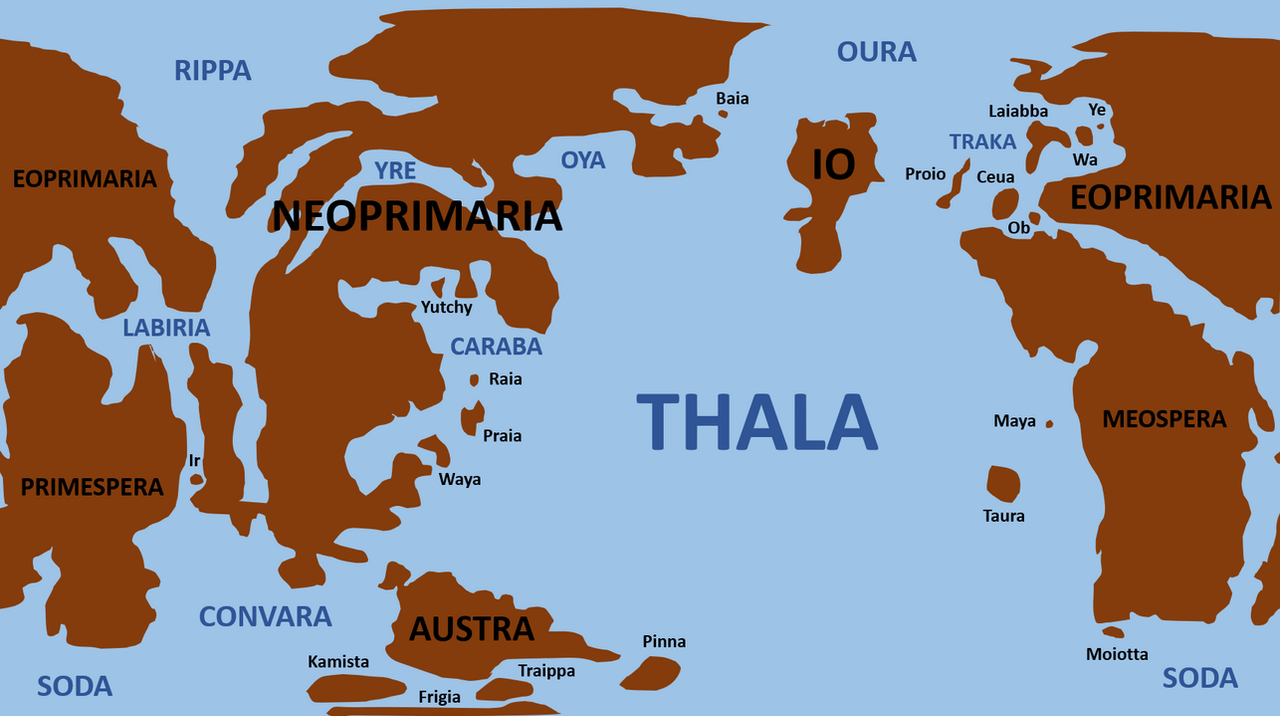HOME | DD
 YellowPanda2001 — Desma Map - 10myps
YellowPanda2001 — Desma Map - 10myps

#crab #mole #seed #snail #speculativeevolution
Published: 2023-10-23 10:02:24 +0000 UTC; Views: 3590; Favourites: 28; Downloads: 2
Redirect to original
Description
10 million years have passed since Desma was seeded. Over time, continents and oceans formed and species evolved in these new conditions. The old continents of Primaria and Hespera have split and reformed in this short period of time. The continent of Eoprimaria is formed from the splitting northwestern portion of Primaria, having merged with the splitting northern parts of the Hespera continent. Hespera itself split in three, with the northern part going north to form Eoprimaria, the western part forming the Meospera continent and the eastern part forming Primespera. The continent of Neoprimaria retains much of the major components of the eastern parts of Primaria. The island continent of Io remains pretty isolated in the north, as well as the continent of Austra, in the south. The Caraba sea, located east to Neoprimaria, retains much of its original insular bodies, such as Waya, Praia and Raia, with a new island, Yutchy, having since formed. The old island of Baia is retained in northeastern coast of Neoprimaria, but the old island of Nealva has merged with Austra, however all the antarctic islands of Kamista, Frigia, Traippa and Pinna are retained. The island of Ir is formed in between Primespera and Neoprimaria. Closer to the coast of Meospera, we have the island of Moiotta, Taura and Maya, which remain around since the beginning. In the sea of Traka, a new archipelago forms next to the old island of Ceua, with islands such as Laiabba, Ye, Wa and Ob. West to this archipelago there's also the Proio island, which is a eastern offshoot from Io that is moving eastwards. The large Thala ocean remains well defined, as well as the Convara and Oura seas. The Rippa sea is formed where the continents of Eoprimaria and Neoprimaria split. The Soda sea defines the antarctic sea that touches the southern parts of Meospera and Primespera. The Yre and Oya seas are ones that bore through the northeastern coasts of Neoprimaria. Finally the Labiria seaway is the name given to the series of oceanic labyrinths that separate the two primarian and the two hesperan continents.Desma is warmer now than 10 million years before. Over the course of this time, the oceans have mostly proven to be a barren wasteland of blue, where the dominant lifeforms proved to be algae and other microorganisms, as well as sea-going fungi and nematodes. More impressive would be the oceanic migrations of species such as some sea-specialized snails and crabs which mostly stick to the coasts for now.
Spinachs have completely dominated the flora on land, with various diverses species, from creeping vines, to bushes, herbs and full on trees being formed in pretty much every recognizable landmass. Forests, shrublands, savannahs, swamplands are now all formed from this singular form of plant.
Desmans have diversified into a myriad of different species across most of their range. They're presently found in Neoprimaria, Austra, Eoprimaria and some surrounding islands. A lineage of shrew-like desmans has recently invaded Meospera as well by rafting, while Primespera is devoid of them. The desman diversity is mostly composed of various shrew-like carnivores, with varying sizes, ranging from just a few centimeters to up to 1.5 meters long. Some desmans have maintained or regained an aquatic foraging lifestyle in various freshwater courses. Others have become arboreal climbers, looking for prey in trees and bushes. Others are specialized burrowers or probers. No herbivorous desmans exist, though some species already incorporate some plant matter in their diet, although for now its a tentative practice.
Crabs are perhaps the most speciose and diverse of all the major animals of Desma. They're currently found in most landmasses, with notable exceptions being Io and Proio. They range from just some millimeters in length to up to half a meter wide, occupying various typical arthropod-like roles. They're represented by ground-dwelling herbivores, omnivores, carnivores, scavengers and filter feeders, having colonized a multitude of environments inland, with some species making the transition to underwater habitats in freshwater courses and some coastal environments. Some are burrowers, others are arboreal specialists, others live on the ground and others in rocks or caves. Some species are pretty colorful and there seems to be a large investment in visual displays which is evident as various different species show different forms and appearances to reflect sexual differentiation strategies between different species.
Finally snails are perhaps the most widespread of the main animal groups of Desma. They're found in pretty much every landmass, for some species are very great at travelling ocean currents to reach to new islands, even those that were not initially seeded with snails. There are many species ranging from just a few millimeters and others reaching over half a meter long. Many species are herbivores, but others are omnivores, carnivores, scavengers or filter feeders. Many species are terrestrial, but a few species adapted to live underwater, in freshwater or in saltwater, with a very recent lineage now becoming pelagic specialists. Io and Proio is unique for being the only major places where snails are the only ones, out of the three main animal groups of this planet, to live there. There, the lack of competition from crabs or desmans has created a strange array of different adaptations, kickstarting a much more surprising evolutionary radiation for this group there.
Related content
Comments: 2

👍: 0 ⏩: 1

👍: 0 ⏩: 0
























